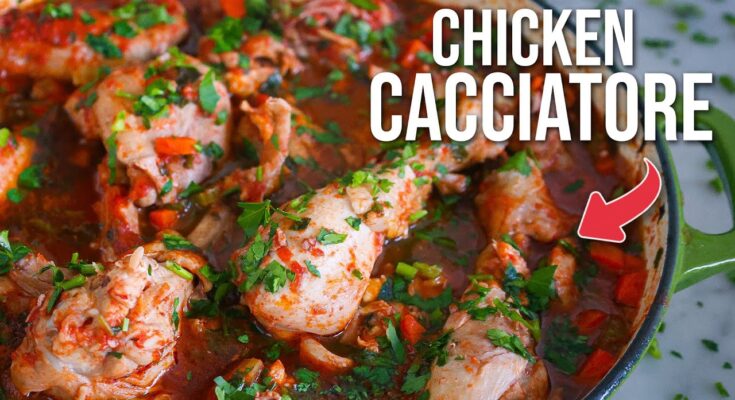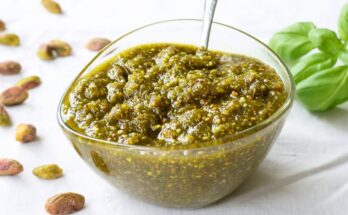Chicken Cacciatore Recipe: Chicken Cacciatore, or “hunter-style chicken,” is a classic Italian dish bursting with rustic flavors.
Originating from the Italian countryside, this hearty recipe combines tender chicken with a rich tomato-based sauce infused with herbs, wine, and sautéed vegetables.
It’s beloved for its versatility and the way it effortlessly balances comfort and elegance. Whether you’re serving it for a cozy family dinner or a special occasion, Chicken Cacciatore never fails to impress.
Ingredients Required
Essential Ingredients:
- 6 chicken thighs or drumsticks (bone-in, skin-on recommended)
- 2 tbsp olive oil
- 1 large onion, diced
- 3 cloves garlic, minced
- 1 red bell pepper, sliced
- 1 green bell pepper, sliced
- 1 cup mushrooms, sliced
- 1 can (28 oz) crushed tomatoes
- 1 cup chicken broth
- 1/2 cup dry red wine (optional)
- 2 tsp dried oregano
- 1 tsp dried thyme
- 2 tbsp fresh parsley, chopped
- Salt and pepper to taste
Substitutions:
- Chicken breasts instead of thighs
- White wine or grape juice for red wine
- Zucchini or carrots instead of mushrooms
Optional Add-ins:
- Olives or capers for a briny kick
- A pinch of chili flakes for spice
- Fresh basil for garnish
Kitchen Tools You’ll Need
Essential Tools:
- Large skillet or Dutch oven
- Sharp chef’s knife
- Cutting board
- Wooden spoon or spatula
- Measuring cups and spoons
Optional Tools for Convenience:
- Garlic press
- Herb stripper for fresh herbs
- Tongs for handling chicken
Preparing the Chicken
- Choosing the Right Cuts: While bone-in, skin-on chicken thighs or drumsticks are traditional, boneless thighs or breasts work well too. Choose high-quality, fresh chicken for the best flavor.
- Cleaning and Seasoning: Rinse the chicken and pat it dry with paper towels. Season generously with salt and pepper. For extra flavor, rub minced garlic or Italian herbs into the meat.
- Browning the Chicken: Heat olive oil in a large skillet over medium-high heat. Sear the chicken on each side for 3-4 minutes until golden brown. Remove and set aside; this locks in moisture and adds flavor to the dish.
Sautéing the Vegetables
- Preparing the Vegetables: Dice the onion finely and slice the bell peppers into thin strips. For the mushrooms, wipe them clean and slice evenly to ensure uniform cooking.
- Sautéing Steps: In the same skillet used for browning the chicken, add the onion and garlic. Cook for 2 minutes until fragrant. Add the bell peppers and mushrooms, stirring occasionally. Sauté for 5-7 minutes until the vegetables are tender.
- Deglazing the Pan: Pour in the wine (if using) and scrape the bottom of the skillet to release any browned bits. This step adds depth to the sauce.
Building the Sauce
- Combining Ingredients: Add the crushed tomatoes, chicken broth, and herbs (oregano and thyme) to the skillet. Stir to combine with the vegetables.
- Balancing Flavors: Adjust seasoning with salt, pepper, and a pinch of sugar if the tomatoes are too acidic. For a richer sauce, add a tablespoon of tomato paste.
- Consistency Check: Simmer the sauce over low heat for 10 minutes, stirring occasionally. Add a splash of water or broth if it thickens too much.
Cooking the Chicken in the Sauce
- Returning the Chicken to the Pan: Once the sauce is ready, carefully place the browned chicken pieces back into the skillet, ensuring they are nestled in the sauce. The sauce should cover the chicken about halfway.
- Simmering for Tenderness: Reduce the heat to low, cover the skillet with a lid, and let the chicken simmer for 30-40 minutes. Turn the chicken occasionally to ensure even cooking. This slow cooking allows the flavors to meld beautifully.
- Avoid Overcooking: Use a meat thermometer to check the internal temperature of the chicken. It should reach 165°F (74°C). If the sauce starts to reduce too much, add a splash of water or broth to keep it from drying out.
Adding Herbs and Final Touches
- Fresh vs. Dried Herbs: While dried oregano and thyme work well during cooking, finish the dish with fresh parsley or basil for a burst of vibrant flavor. Fresh herbs brighten up the rich sauce.
- Adding Final Seasonings: Taste the sauce before serving. Adjust salt, pepper, or add a pinch of red pepper flakes for heat. A drizzle of olive oil over the finished dish adds a luxurious touch.
- Optional Garnishes: Sprinkle grated Parmesan or Pecorino Romano cheese on top, or add a handful of olives or capers for extra complexity.
Serving Suggestions
- Classic Pairings: Serve Chicken Cacciatore over al dente pasta such as spaghetti, linguine, or pappardelle. It also pairs beautifully with creamy polenta or crusty Italian bread to soak up the sauce.
- Low-Carb Options: For a lighter alternative, serve over zucchini noodles, cauliflower rice, or a bed of sautéed spinach.
- Wine Pairings: Complement the dish with a glass of Chianti, Sangiovese, or a robust Pinot Noir. For non-alcoholic options, sparkling water with a slice of lemon works wonderfully.
Common Variations of Chicken Cacciatore
- Regional Twists:
- Northern Italy: Features white wine and fewer tomatoes, resulting in a lighter sauce.
- Southern Italy: Incorporates more tomatoes, red wine, and spicy chili flakes.
- Vegetarian Version: Replace the chicken with hearty vegetables like eggplant, zucchini, and chickpeas. Adjust cooking time accordingly.
- Seafood Cacciatore: Swap chicken for shrimp or fish like cod or halibut. Reduce cooking time to avoid overcooking the seafood.
Storing and Reheating Leftovers
- Storage Tips: Allow the dish to cool completely before transferring it to an airtight container. Refrigerate for up to 3 days or freeze for up to 3 months.
- Reheating Instructions: Reheat on the stovetop over low heat, adding a splash of broth or water to loosen the sauce. If microwaving, use medium heat and stir occasionally for even warming.
- Freezing Advice: For best results, freeze the chicken and sauce separately. Thaw overnight in the refrigerator before reheating.
Pro Tips for a Perfect Chicken Cacciatore
- Build Layers of Flavor: Browning the chicken and deglazing the pan are essential for adding depth to the dish. Don’t skip these steps!
- Choose the Right Wine: Use a wine you’d drink—its flavor will shine through. For a non-alcoholic option, try grape juice with a splash of vinegar.
- Don’t Rush the Simmering: Slow cooking allows the sauce to thicken naturally and the chicken to absorb the rich flavors.
Health Benefits of Chicken Cacciatore
Nutritional Highlights:
- High in protein from the chicken
- Packed with antioxidants from tomatoes and vegetables
- Low in saturated fat if you use skinless chicken or limit the olive oil
Making it Healthier:
- Use skinless chicken to reduce fat content.
- Add extra vegetables for more fiber and nutrients.
Dietary Options:
- Gluten-free: Serve with gluten-free pasta or rice.
- Keto-friendly: Skip the wine and serve over cauliflower rice.
FAQs about Chicken Cacciatore Recipe
1. What is Chicken Cacciatore?
Chicken Cacciatore is a classic Italian dish that translates to “hunter’s style.” It features chicken cooked in a rich tomato-based sauce with vegetables like onions, bell peppers, and mushrooms, often flavored with herbs and wine.
2. What type of chicken should I use?
You can use any chicken parts for this recipe, such as thighs, drumsticks, or breasts. Bone-in and skin-on pieces are traditional, as they add more flavor, but boneless options work just as well.
3. Can I make Chicken Cacciatore without wine?
Yes, you can substitute wine with chicken broth, vegetable broth, or even water if you prefer an alcohol-free version. The dish will still be delicious!
4. What sides pair well with Chicken Cacciatore?
Chicken Cacciatore pairs wonderfully with pasta, rice, or crusty bread. Mashed potatoes or roasted vegetables are also great options to complete the meal.
5. Can I make Chicken Cacciatore in advance?
Absolutely! Chicken Cacciatore tastes even better the next day as the flavors deepen. Store it in an airtight container in the refrigerator for up to 3 days.
6. Is this recipe freezer-friendly?
Yes, Chicken Cacciatore freezes well. Allow it to cool completely, then store it in a freezer-safe container for up to 3 months. Thaw overnight in the refrigerator before reheating.
7. Can I make a vegetarian version of Chicken Cacciatore?
Yes, you can replace the chicken with hearty vegetables like eggplant, zucchini, or mushrooms for a vegetarian-friendly twist on this dish.
With these FAQs, preparing a flavorful Chicken Cacciatore becomes a breeze. Try this comforting Italian classic and make it your own!
Conclusion
Chicken Cacciatore is a timeless dish that transforms simple ingredients into a rich, flavorful masterpiece. Its versatility, comforting warmth, and ease of preparation make it a go-to recipe for busy weeknights and special occasions alike. By following this step-by-step guide, you’ll master the art of making Chicken Cacciatore and bring a taste of Italy into your home.



